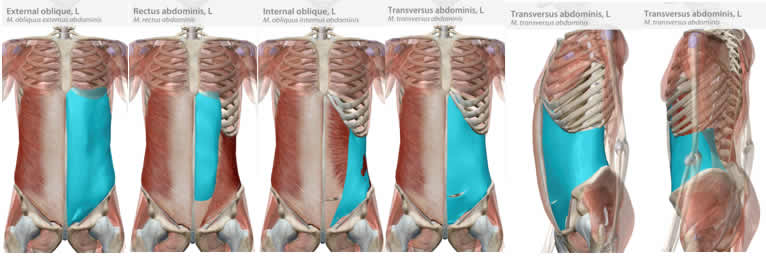
Unless you have been diagnosed with it, chances are, you haven’t heard about Diastasis Recti, DR, or DRA (diastasis recti abdominis), as it is commonly known.
Frequently linked to pregnancy, DR is often thought of as a postpartum condition. However, men and women who haven’t been pregnant also experience DR. In my practice, I have actually seen more men with DR than women.
What is Diastasis Recti?
Diastasis Recti is a vertical separation of the rectus abdominis muscle and stretching of the corresponding connective tissue, the Linea Alba. The rectus abdominis, also known as the six-pack muscle, is a long muscle with a corresponding right and left side connected by the Linea Alba.
What are the Signs of Diastasis Recti?
Depending on the size of your DR, it may be visible when you are standing. The separation looks ellipse-like. A tell-sign of DR is doming when curling up as when performing a crunch. The area where the DR is appears in the shape of a tent. Some people may have a pooch also lovingly known as a mommy pooch or a beer gut, for the gentlemen.
Diastasis recti may be accompanied by conditions such as back pain, constipation, painful intercourse, prostate issues, and even hernias, for example.
Let’s Do a Quick Anatomy Lesson
… and review the layered abdominal muscles. You will see where we are going with this mini tutorial.
Note that there is a right and left side of each muscle. On the top, there are the external obliques. When “peeled off”, underneath is the rectus abdominis, the muscle affected by DR, and the internal obliques. When these are “peeled”, underneath is the posture champ – the transversus abdominis, also known as TA.
Observe two things:
- The depth of the TA
- The size of the TA – last 3 photos.
Ideally, there will be a balance in how the muscles activate while you are in motion, and the TA will be an active participant. The TA is a postural muscle – as a corset, it assists you to stay erect. As such, the TA is a key core stabilizer, ensuring the stability of the spine and pelvis. It also provides support for organs.
The bad news is, that during movement without core awareness and especially hard-core exercises, the rectus and obliques do most of the work while the TA is neglected. The truth is, most people don’t know how to engage their TA – this is where people like me come to the rescue.
Have you ever heard that crunches are not an effective exercise? This is because frequently, people end up pushing their abs out or overemphasizing their rectus while not doing anything with the TA which … ding, ding is how DR starts happening. When undue pressure is placed on the rectus abdominis muscle and the connective tissue, DR could be the result.
With DR, the TA is usually checked out. It could have been weakened, such as postpartum, or is not activating properly due to misalignments and compensations. A prime example I see all the time in my practice is hyperactive hip flexors and dormant TA.
When someone is chronically pushing their abs out – whether it is while lifting heavy weights, doing abdominal exercises inaccurately, or sitting or standing with poor posture – undue pressure is placed on the connective tissue and damage happens over time. During pregnancy, the pressure is obvious – the growing belly.
Also note that DR could be reinforced by issues such as an incorrect breathing pattern or misalignments that cause the body to be out of homeostasis – if you want to read more on this topic, check out the recent blog on The Implications of Sitting on Posture.

How is Diastasis Recti Diagnosed?
Note that Diastasis Recti is a medical condition and has to be diagnosed by a trained professional such as a doctor or physical therapist.
If you suspect you have Diastasis Recti, you can do this test but not in lieu of a medical diagnosis.
Lie down on your back. Bend knees and place feet on the floor. Keep feet hip-width apart. With one hand, support your head as you lift the head off the floor and curl up into a crunch position. Take the 2nd, 3rd, and 4th fingers of the opposite hand and place them vertically with your middle finger into your belly button. Start moving all 3 fingers up and down in a straight line. Is there resistance or do your fingers sink in? If the latter, how many fingers can you place sideways into the opening? An opening of more than 2 fingers is considered DR.
How Do I Know How Bad My Diastasis Recti is?
In DR, there are 3 things to pay attention to:
- How long is the DR? Is it one area – e.g., right around the belly button or higher between the ribs or along the muscle? In my experience, for women postpartum, I usually see a more localized DR around the belly button area while for men the opening is longer.
- How wide is the DR – how many fingers fit in the opening?
- How deep is the DR – how much resistance is there when the fingers sink in? The less resistance, the worse the DR.
What Are the Risk Factors for Pregnancy and Diastasis Recti?

What Are the Risk Factors for Pregnancy and Diastasis Recti?
According to an observational study on the risk factors of pregnant women for DR “No statistically significant differences were found in pre-pregnancy body mass index (BMI), weight gain, baby’s birth weight or abdominal circumference between women with and without DRA at 6 months postpartum.”
Another study found that: “DRA incidence was significantly higher in those who underwent cesarean section (CS) than in those who underwent vaginal delivery.”
What Should I be Careful with if I Have Diastasis Recti?
If you are postpartum:
- Make sure to receive medical clearance prior to returning to working out.
- Do not start prematurely early especially if you don’t know how to engage your abdominals properly.
If you already have DR:
- Ensure you are properly engaging your abdominals, especially the TA, and breathing when exercising.
- If your belly pokes out, this is a sign you are not engaged and/ or you are unable to sustain the effort (e.g., range of motion is too big and/or weight is too heavy).
- Soften the ribs in and down while gently pulling your pubic bone in towards the spine and up towards your ribs.
- Test – look and touch, throughout the range of motion – neither should your belly poke out nor should your fingers sink in when your cylinder (aka core) is engaged.
- Beware when lifting anything heavy – e.g., baby, grocery bags, weights – and when flexing your spine and bending forward – e.g., reaching for the floor from a standing position, crunches – your cylinder has to be solid.
- Work on strengthening your core, especially the TA.
- Sit and stand in alignment and with good posture.
With DR, it is important to pinpoint the cause of the problem. If you are unsure whether you are in alignment, properly engaging, and/or breathing, do yourself a favor and hire a professional who can assist you to address the underlying cause.
Need a visual explanation? Check out this video to learn more about Diastasis Recti and learn some good and bad practices regarding the condition.
Happy healing!
Maria
